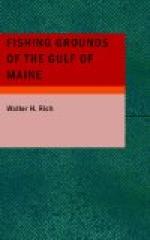The whole western coast of Nova Scotia is herring ground at some season of the year. “Drifting” for herring was formerly a considerable industry from Digby to Briers Island, but in these last few years it has not been important, although the year 1927 had a very good run of large food fish. This western coast is also an important fishing area for lobster men.
Swordfishing in the Bay of Fundy was formerly profitable in September, although these fish were never so numerous here as upon the outer shore of Nova Scotia.
St. Marys Bay is a summer herring ground. Good haddocking may be had here, also, from April 15 to October 15, with the period from the opening of the fishing in April up to July 15 the best of it.
The mackerel fishery of the Bay of Fundy seems of comparatively small importance in these latter years. The local fishermen say that the fish can not stem the tides of these waters! The abundance of small herring should be an inducement sufficient to bring them here. Apparently these fish pass straight inshore northwesterly and reach the coast of Maine. A considerable amount of this species is taken by traps and by netting in St. Marys Bay and in the general vicinity of Yarmouth, Nova Scotia, as at Cranberry Head, Burns Point. Beaver River, Woods Harbor, and at various other points between Yarmouth and Cape Sable; but the inner waters of the Bay of Fundy show very slim catches when compared with the great amount taken on the outer shores of Nova Scotia in a normal mackerel season. It has been 32 years, it is said, since any number of mackerel have been “hooked” in St. Mary’s Bay.
Lurcher Shoal. This lies WSW, from Cape St, Mary 19 miles and WNW, from Cape Fourchu, distant 13 miles, it is an irregularly shaped piece of bottom, a rocky ground, about 5 miles long, north and south, by 3 miles wide, There are a number of “nubbles” arising to 5, 7, and 9 fathom depths—with a spot reported as having only 12 feet of water over it— rising from the average depths over the rest of the shoal of from 13 to 15 fathoms. Over this generally rocky bottom are scattered patches of gravel and of shells, Depths about the shoal are from 30 to 50 fathoms over a bottom consisting mostly of stones, Tide rips are very heavy here, The seasons and species found here are as on Trinity: cod, haddock, pollock, and herring, it is a good lobster ground.
Trinity Shoal. This shoal, 14 miles N. by W. from Cape Fourchu and 7 1/2 miles SW. from Cape St Mary, with a rocky bottom upon it and over an indefinite area about it, is perhaps 3 miles long, NE and SW, by some 2 miles wide. Near the center is a rock, uncovered at low water, but over the greater part of the shoal there are depths of from 6 to 10 fathoms, with an average of from 12 to 16 fathoms over the sandy and stony ground about it. There is a strong tide rip here on the eastern and northeastern part known as Flood Tide Eddy, where is good fishing by hand line for pollock in September and October. Cod and haddock are taken here in small amounts by trawling. It is a herring ground also, and there is a lobster ground on the shoal and all about it.




